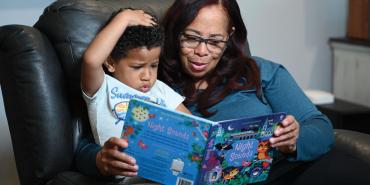There are several ways that people might read words. They can sound out and blend letters to decode words. They can read new words by analogy; for example, if they already know play and jump, they can read plump. They can use prior meanings in a sentence or text to predict words (and to confirm that words read in other ways fit the meaning of the text).
Words that readers have read before and have stored in memory can be read automatically by sight. Readers can look at word spellings and recognize the pronunciations and meanings immediately without having to stop and decode, analogize, or predict words. This enables them to read text easily. The meanings of words just pop into their minds without any effort and enable them to focus on the meaning of the text.
In elementary school, an important goal of reading instruction is to enable children to read most words automatically by sight so that they can focus on learning from and enjoying what they are reading. But becoming a strong reader takes several years. As a parent or caregiver, you need to know if your child is making good progress in learning to read. Along with many colleagues, I’ve been studying how children learn to read for more than 50 years. My research suggests that children move through four phases on their way to becoming joyful, confident readers.1
1. Pre-Alphabetic Phase
During the pre-alphabetic phase, which is typical of three- and four-year-olds who have not yet begun reading instruction, children have little knowledge of how letters represent sounds, so they use visual or context cues to read (or guess) words. For example, they may use the golden arches rather than the letter M to read “McDonald’s.” They may know letters in their own names, but these are memorized rather than connected to the sounds in their names.
Children’s spoken vocabularies grow during this phase, especially when adults read books to them. The more words they know, the easier it will be to build their reading-by-sight vocabularies later on. So, try reading to your child every day. It will become a fun time to snuggle up together—and you’ll be helping your child grow into a strong reader.
2. Partial Alphabetic Phase
To move into the partial alphabetic phase, children need to learn letter shapes, names, and sounds. They also need to be taught how to detect the smallest sounds (which are called phonemes) in spoken words. For example, help has four phonemes (each letter makes a sound), and chick has three phonemes (because c and h are combined to make one sound and likewise c and k). Typically, children in the partial alphabetic phase are in kindergarten or first grade; they know letter names and some letter sounds, but they have not received systematic instruction in how letters represent sounds. Older struggling readers may also be stuck in this phase and therefore need more instruction and practice.
Distinguishing phonemes is hard because there are no breaks between them in spoken words. Instruction in how letters represent sounds—like ch making the first sound in chick—helps children distinguish phonemes in speech. Another instructional strategy that helps is analyzing the positions and movements of parts of the mouth to pronounce words. For example, to distinguish the three phonemes in mat, children can learn that first the lips are closed to say the sound /m/, then opened to say /a/, and then the tongue is lifted to the roof of the mouth to say /t/. Developing this awareness of phonemes enables readers to form connections between the sounds in words they pronounce and the letters used to spell those words—and that helps them store words in memory and get closer to reading automatically by sight.
To read and write words in the partial alphabetic phase, children apply their partial knowledge of the spelling system to connect some letters in words to sounds. For example, a child trying to spell mail might write “ML.” Children in this phase can also use letter names to write salient sounds in words, such as “LFT” for elephant. However, they don’t know enough about how letters represent sounds to decode unknown words or to spell words correctly.
To help your child during this phase, you can play word games like changing the first letter of a word to make new words—mat, sat, hat, cat, bat—and encourage your child to write the sounds they hear in words (knowing that misspellings are OK for now).
3. Full Alphabetic Phase
To move into the full alphabetic phase, children need to acquire the major letter-sound (grapheme-phoneme) relations of the writing system. They need to acquire decoding skill to sound out letters and blend the sounds to form words. The type of reading instruction that helps children master these skills is called phonics. In systematic phonics instruction, teachers follow a “scope and sequence” chart to teach the major letter-sound relations; they also teach segmenting sounds, decoding words, and spelling skills. Phonics instruction can reduce the time that students spend in the partial alphabetic phase and move them quickly into the full phase, typically by the end of kindergarten or in first grade. The skills children acquire help them store words in their memory for reading by sight and spelling words correctly.
To help your child develop these skills, encourage them to read aloud to you and to try to decode unknown words. This will help your child bond the spellings of words to their pronunciations in their memory. You can also help your child read new words in text (like a complete sentence or a short book that contains many words they can already read). This is especially important to learn words whose meanings depend on context, such as with function words (was, from, with), irregular past-tense verbs (held, took, kept), and words that sound the same but have different spellings and meanings (ate/eight, to/two/too, rode/road). If these words are read in isolation, your child might learn the wrong meanings or no meanings.
4. Consolidated Alphabetic Phase
With intentional, systematic phonics instruction in kindergarten and first grade, and much practice reading words in text and spelling words, children move closer to the consolidated alphabetic phase in second grade. As readers in the full phase store more and more words in memory, they learn about spelling patterns. In the consolidated phase, combinations of letter sounds that recur across different words become consolidated into multi-letter spelling units, such as syllables (li-ber-ty in liberty), prefixes (un in unless), and suffixes (tion in education). Children can use these units to form connections between spellings of multisyllabic words and their pronunciations—and that helps them read and spell with ease and confidence.
For example, to learn the word interesting, children might isolate each written syllable (in-ter-est-ing) while pronouncing it and then blend the parts to read the whole word.2 Repeated practice with different multisyllabic words can improve children’s memory for the words. You can make this practice fun by spotting multisyllabic words—like library, grocery, playground, basketball, restaurant, and museum—in everyday life and helping your child read them by isolating the separate syllables and decoding these parts, then saying the whole word.
Conclusion
These four phases help us understand the emergence of word reading and spelling skills and identify what type of instruction is needed. Here’s a quick summary of the key skills to reinforce at home:
- In the pre-alphabetic phase, help your child learn letters and build their spoken vocabulary.
- To move into the partial phase, help your child hear the small sounds in words and learn how letters represent sounds in words.
- To move into the full phase, develop your child’s knowledge of the major letter-sound relations and their use to decode new words to build a reading-by-sight vocabulary and to spell words.
- To move into the consolidated phase, support your child’s growing knowledge of multi-letter units in the spelling system (like -ing, -tion, -ed) to read and write words.
In school, children benefit most from systematic phonics instruction to acquire these skills. One great way to support your child’s growth at home is to create lots of opportunities for them to practice reading—and to talk about what you’ve read together to boost their comprehension. And if your child is not progressing through the four phases, be sure to go to their school to ask for additional supports.
Linnea C. Ehri, a member of the Reading Hall of Fame and the National Reading Panel, has been researching how children learn to read and write since 1970.
Endnotes
1. Alphabetic phase theory portrays the course of development in learning to read and spell words. L. Ehri, “Development of Sight Word Reading: Phases and Findings,” in The Science of Reading: A Handbook, ed. M. Snowling and C. Hulme (Oxford, UK: Blackwell, 2005), 135–54; L. Ehri, “Orthographic Mapping in the Acquisition of Sight Word Reading, Spelling Memory, and Vocabulary Learning,” Scientific Studies of Reading 18, no. 1 (2014): 5–21; L. Ehri, “The Science of Learning to Read Words: A Case of Systematic Phonics Instruction,” Reading Research Quarterly 55, no. 1 (2020): S45–S60; and L. Ehri, “What Teachers Need to Know and Do to Teach Letter-Sounds, Phonemic Awareness, Word Reading, and Phonics,” The Reading Teacher 76, no. 1 (2022): 53–61.
2. A. Bhattacharya and L. Ehri, “Graphosyllabic Analysis Helps Adolescent Struggling Readers Read and Spell Words,” Journal of Learning Disabilities 37 (2004): 331–48.
[photos: Bob Riha, Jr. and Suzannah Hoover]



